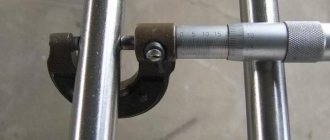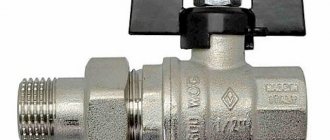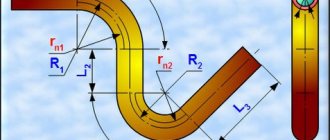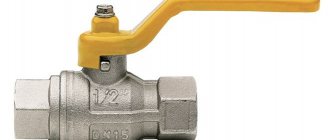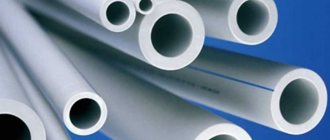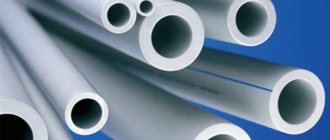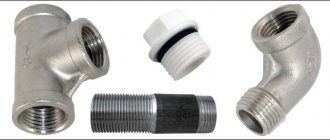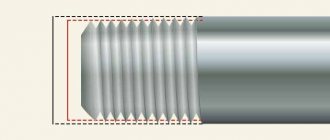Her Majesty the trumpet! Of course, it makes our lives better. Like that:
The key characteristic of any cylindrical pipe is its diameter. It can be internal ( Dу ) and external ( Dn ). Pipe diameter is measured in millimeters, but the unit of pipe thread is inch.
At the junction of the metric and foreign measurement systems, the most questions usually arise.
In addition, the actual size of the internal diameter often does not coincide with Dy .
Let's take a closer look at how we can continue to live with this. A separate article is devoted to pipe threads; click here to read more.
Inches vs mm. Where does the confusion come from and when is a correspondence table needed?
Pipes, the diameter of which is indicated in inches ( 1″, 2″ ) and/or fractions of inches ( 1/2″, 3/4″ ), are a generally accepted standard in water and water gas supply.
What's the difficulty?
Take dimensions from a 1″ (how to measure pipes is described below) and you will get 33.5 mm , which naturally does not coincide with the classic linear conversion table for inches to mm ( 25.4 mm ).
As a rule, the installation of inch pipes proceeds without difficulty, but when replacing them with pipes made of plastic, copper and stainless steel, a problem arises - the discrepancy between the size of the indicated inch ( 33.5 mm ) and its actual size ( 25.4 mm ).
Usually this fact causes bewilderment, but if you look deeper into the processes occurring in the pipe, the logic of the size discrepancy becomes obvious to a layman. It's quite simple - read on.
The fact is that when creating a water flow, the key role is played not by the external, but by the internal diameter, and for this reason it is used for designation.
However, the discrepancy between designated and metric inches still remains, since the internal diameter of the standard pipe is 27.1 mm , and the reinforced one is 25.5 mm . The last value is quite close to the equality 1”=25.4 , but still it is not it.
The solution is that to designate the size of pipes, a nominal diameter rounded to a standard value is used (nominal diameter Dy ). The nominal diameter is selected so that the pipeline capacity increases from 40 to 60% depending on the increase in the index value.
Example:
The outer diameter of the pipe system is 159 mm, the pipe wall thickness is 7 mm. The exact internal diameter will be D = 159 - 7 * 2 = 145 mm. With a wall thickness of 5 mm, the size will be 149 mm. However, in both the first and second cases, the conditional passage will have one nominal size of 150 mm.
In situations with plastic pipes, adapters are used to solve the problem of inappropriate sizes. If it is necessary to replace or connect inch pipes with pipes made according to real metric dimensions - copper, stainless steel, aluminum, both the outer and inner diameters should be taken into account.
Table of nominal diameter in inches
| Du | Inches | Du | Inches | Du | Inches |
| 6 | 1/8″ | 150 | 6″ | 900 | 36″ |
| 8 | 1/4″ | 175 | 7″ | 1000 | 40″ |
| 10 | 3/8″ | 200 | 8″ | 1050 | 42″ |
| 15 | 1/2″ | 225 | 9″ | 1100 | 44″ |
| 20 | 3/4″ | 250 | 10″ | 1200 | 48″ |
| 25 | 1″ | 275 | 11″ | 1300 | 52″ |
| 32 | 1(1/4)» | 300 | 12″ | 1400 | 56″ |
| 40 | 1(1/2)» | 350 | 14″ | 1500 | 60″ |
| 50 | 2″ | 400 | 16″ | 1600 | 64″ |
| 65 | 2(1/2)» | 450 | 18″ | 1700 | 68″ |
| 80 | 3″ | 500 | 20″ | 1800 | 72″ |
| 90 | 3(1/2)» | 600 | 24″ | 1900 | 76″ |
| 100 | 4″ | 700 | 28″ | 2000 | 80″ |
| 125 | 5″ | 800 | 32″ | 2200 | 88″ |
Inner and outer diameters
Table of correspondence between nominal diameter, thread and outer diameters of the pipeline in inches and mm.
| Nominal pipe diameter Dy. mm | Thread diameter G". inch | Pipe outer diameter Dn. mm | ||
| Water/water-gas pipes GOST 3263-75 | Epoxy-welded straight-seam steel pipes GOST 10704-91. Seamless hot-deformed steel pipes GOST 8732-78. GOST 8731-74 (FROM 20 TO 530 ml) | Polymer pipe. PE, PP, PVC | ||
| 10 | 3/8″ | 17 | 16 | 16 |
| 15 | 1/2″ | 21.3 | 20 | 20 |
| 20 | 3/4″ | 26.8 | 26 | 25 |
| 25 | 1″ | 33.5 | 32 | 32 |
| 32 | 1 1/4″ | 42.3 | 42 | 40 |
| 40 | 1 1/2″ | 48 | 45 | 50 |
| 50 | 2″ | 60 | 57 | 63 |
| 65 | 2 1/2″ | 75.5 | 76 | 75 |
| 80 | 3″ | 88.5 | 89 | 90 |
| 90 | 3 1/2″ | 101.3 | ||
| 100 | 4″ | 114 | 108 | 110 |
| 125 | 5″ | 140 | 133 | 125 |
| 150 | 6″ | 165 | 159 | 160 |
| 160 | 6 1/2″ | 180 | 180 | |
| 200 | 219 | 225 | ||
| 225 | 245 | 250 | ||
| 250 | 273 | 280 | ||
| 300 | 325 | 315 | ||
| 400 | 426 | 400 | ||
GOST - state standard used in heat - gas - oil - pipelines
ISO - standard for designating diameters, used in plumbing engineering systems
SMS - Swedish standard for pipe diameters and valves
DIN / EN - the main European standard for steel pipes according to DIN2448 / DIN2458
DN (Dy) - nominal diameter
Tables with sizes of polypropylene pipes are presented in the following article >>>
Compliance of the nominal diameter with international markings
| GOST | ISO inch | ISO mm | SMS mm | DIN mm | DU |
| 8 | 1/8 | 10,30 | 5 | ||
| 10 | 1/4 | 13,70 | 6,35 | 8 | |
| 12 | 3/8 | 17,20 | 9,54 | 12,00 | 10 |
| 18 | 1/2 | 21,30 | 12,70 | 18,00 | 15 |
| 25 | 3/4 | 26,90 | 19,05 | 23(23) | 20 |
| 32 | 1 | 33,70 | 25,00 | 28,00 | 25 |
| 38 | 1 ¼ | 42,40 | 31,75 | 34(35) | 32 |
| 45 | 1 ½ | 48,30 | 38,00 | 40,43 | 40 |
| 57 | 2 | 60,30 | 50,80 | 52,53 | 50 |
| 76 | 2 ½ | 76,10 | 63,50 | 70,00 | 65 |
| 89 | 3 | 88,90 | 76,10 | 84,85 | 80 |
| 108 | 4 | 114,30 | 101,60 | 104,00 | 100 |
| 133 | 5 | 139,70 | 129,00 | 129,00 | 125 |
| 159 | 6 | 168,30 | 154,00 | 154,00 | 150 |
| 219 | 8 | 219,00 | 204,00 | 204,00 | 200 |
| 273 | 10 | 273,00 | 254,00 | 254,00 | 250 |
Diameters and other characteristics of stainless steel pipes
| Passage, mm | diameter , mm | Wall thickness, mm | Weight of 1 m pipe (kg) | |||
| standard | reinforced | standard | reinforced | |||
| 10 | 17 | 2.2 | 2.8 | 0.61 | 0.74 | |
| 15 | 21.3 | 2.8 | 3.2 | 1.28 | 1.43 | |
| 20 | 26.8 | 2.8 | 3.2 | 1.66 | 1.86 | |
| 25 | 33.5 | 3.2 | 4 | 2.39 | 2.91 | |
| 32 | 42.3 | 3.2 | 4 | 3.09 | 3.78 | |
| 40 | 48 | 3.5 | 4 | 3.84 | 4.34 | |
| 50 | 60 | 3.5 | 4.5 | 4.88 | 6.16 | |
| 65 | 75.5 | 4 | 4.5 | 7.05 | 7.88 | |
| 80 | 88.5 | 4 | 4.5 | 8.34 | 9.32 | |
| 100 | 114 | 4.5 | 5 | 12.15 | 13.44 | |
| 125 | 140 | 4.5 | 5.5 | 15.04 | 18.24 | |
| 150 | 165 | 4.5 | 5.5 | 17.81 | 21.63 | |
Did you know?
What ingenious lamps can you assemble with your own hands from an ordinary metal pipe? Anyone can do this! Find out more at the link >>>
Metal products and their outer diameters
All types of metal pipes are manufactured at the factory, based on their outer diameter “Dн”. Standard diameters are shown in the table below.
In industry and construction, they mainly use products whose diameters are in the range of 426–1420 mm. Intermediate standard sizes of water pipes are taken from the table.
Small D metal products are mainly used for laying water pipes in residential buildings.
Medium D metal pipelines are used for laying city water supply. Such water pipes are used by industrial systems involved in the extraction of crude oil.
Large sizes of steel pipelines have found application in the creation and laying of main oil pipelines. They are also used in the gas industry. Through such pipelines gas is supplied to every corner of the planet.
Which pipe is considered small - medium - large?
Even in serious sources I have seen phrases like: “We take any pipe of average diameter and...”, but no one indicates what this average diameter is.
To figure it out, you should first understand what diameter you need to focus on: it can be internal or external. The first is important when calculating the transport capacity of water or gas, and the second is important for determining the ability to withstand mechanical loads.
External diameters:
- From 426 mm is considered large;
- 102-246 is called average;
- 5-102 is classified as small.
As for the internal diameter, it is better to look at the special table (see above).
Inner diameter
This metal pipe size (Din) can have different values. Moreover, the value of external D always remains unchanged. To standardize the diameter of water supply pipes, designers use a special value called “nominal diameter”. This diameter has its own designation Dу.
In fact, the nominal diameter is the minimum value of the internal diameter of a given product, rounded to the nearest whole number. Rounding is always performed towards the maximum value only. The value of conditional D is regulated by GOST 355–52.
To calculate internal D, a special formula is used:
Din = Dn – 2S.
The internal diameters of steel products range from 6 to 200 millimeters. All intermediate values are shown in the corresponding table.
The diameter of metal pipes is also measured in inches, which is 25.4 millimeters. The table below shows the product diameters in both inches and millimeters.
How to find out the diameter of a pipe? Measure!
For some reason this strange question often comes to e-mail and I decided to supplement the material with a paragraph about measurement.
In most cases, when purchasing, it is enough to look at the label or the seller. But it happens that you need to repair one of the communication systems by replacing pipes, and initially it is not known what diameter the already installed ones have.
There are several ways to determine the diameter, but we will list only the simplest ones:
- Arm yourself with a tape measure or a measuring tape (this is how women measure their waist). Wrap it around the pipe and record the measurement. Now, to obtain the desired characteristic, it is enough to divide the resulting figure by 3.1415 - this is the number Pi.
Example:
Let's imagine that the girth (circumference L) of your pipe is 59.2 mm . L=ΠD, resp. the diameter will be: 59.2 / 3.1415 = 18.85 mm .
- After obtaining the outer diameter, you can find out the inner one. Only for this you need to know the thickness of the walls (if there is a cut, just measure with a tape measure or other device with a millimeter scale).
Let's assume that the wall thickness is 1 mm. This figure is multiplied by 2 (if the thickness is 3 mm, then it is also multiplied by 2 in any case) and subtracted from the outer diameter (18.85- (2 x 1 mm) = 16.85 mm) .
It’s great if you have a caliper at home. The pipe is simply grabbed by the measuring teeth. We look at the required value on a double scale.
Classification of water pipes
Historically, measurements were calculated in inches. This meaning differed in each state. It was conventionally equated to:
- the width of the index finger;
- the length of three barley grains from the middle of the spikelet;
- the ratio of the distance from the tip of the nose to the thumb of the outstretched hand of King Henry 1 of England.
As a result of the development of civilization and relationships between states, people realized that it was inconvenient to use such a value for full-fledged trade. For this reason, everyone switched to a common measuring system and distances began to be measured in meters. The value of the current meter was fixed in 1983 at the XVII General Conference on Weights and Measures. At this stage it is tied to the speed of light. Despite this, diameters in water pipes continue to be measured in inches. It is officially recognized that this unit is equivalent to 0.0254 meters, or 25.4 mm.
Types of steel pipes according to their production method
- Electric welded (straight seam)
For their manufacture, strips or sheet steel are used, which are bent to the required diameter using special equipment, and then the ends are connected by welding.
The effect of electric welding guarantees a minimum seam width, which makes it possible to use them for the construction of gas or water pipelines. The metal is in most cases carbon or low alloy.
The indicators of finished products are regulated by the following documents: GOST 10704-91, GOST 10705-80 GOST 10706-76 .
Please note that a pipe manufactured in accordance with standard 10706-26 is distinguished by the maximum strength among its peers - after creating the first connecting seam, it is reinforced with four additional ones (2 inside and 2 outside).
The regulatory documentation indicates the diameters of products produced by electric welding. Their size ranges from 10 to 1420 mm.
- Spiral seam
The material for production is steel in rolls. The product is also characterized by the presence of a seam, but unlike the previous production method, it is wider, which means the ability to withstand high internal pressure is lower. Therefore, they are not used for the construction of gas pipeline systems.
A specific type of pipe is regulated by GOST number 8696-74.
- Seamless
The production of a specific type involves the deformation of specially prepared steel blanks. The deformation process can be carried out both under the influence of high temperatures and in a cold way (GOST 8732-78, 8731-74 and GOST 8734-75, respectively).
The absence of a seam has a positive effect on the strength characteristics - the internal pressure is evenly distributed over the walls (there are no “weak” places).
As for diameters, standards control their production with a value of up to 250 mm. When purchasing products with sizes exceeding those indicated, you have to rely only on the integrity of the manufacturer.
It is important to know!
If you want to buy the most durable material, buy seamless cold-formed pipes. The absence of temperature influences has a positive effect on preserving the original characteristics of the metal.
Also, if the ability to withstand internal pressure is an important indicator, then choose round products. Profile pipes cope better with mechanical loads (metal frames, etc., are well made from them).
Here are a couple more excellent slides of creative advertising for a pipe manufacturer:
How to check quality
Since the internal clearance can be different, you have to control the external dimensions and wall thickness. Thickness is more important. It must be measured at different points, at both ends of the pipe. Approximately this parameter can be tracked by the mass of a linear meter.
By the way, there can be considerable deviations in wall thickness. The standard allows deviations both upward and downward. If the diameter of steel pipes is no more than 40 mm, permitted deviations are up to 0.4 mm in the direction of increase and up to 0.5 mm in the direction of decrease. There are two categories of pipe production: regular and high precision. For products of increased precision, the deviation towards decreasing wall thickness is slightly less.
Permissible deviations for VGP
Examples of designations for pipes that are manufactured in accordance with this standard: pipe 20*2.8 GOST 3262-75. It should be read as a pipe with a standard diameter of 20 and a wall thickness of 2.8 mm. From the table you can determine that this is a pipe of normal strength with an outer diameter of 26.8 mm. There you can also find the approximate mass of a meter depending on the thickness of the walls.
How to deal with import designations
There are not only products from domestic manufacturers on the market. There are pipes marked according to the American system. Let's start with the fact that they distinguish between two types of pipes: pipes and tubes. Both words translate as pipe, but they are intended for different systems and the requirements for them are different.
Pipes type
Type of Pipes - electric welded and seamless. They are designed for transporting liquids and gases. So this is exactly the type that can be used in our heating and water supply systems. The main characteristic of pipes type pipes is the internal diameter. There are two strength standards in this group, which determines wall thickness and operating pressure.
- Schedule 40 or standard. The designation may include st (as in the figure below). These are products with standard wall thickness.
- Schedule 80 or extra heavy. The designation is EX. This is a material for use in high pressure pipelines.
Difference in internal diameters of Pipes of different strength categories: standard and heavy.
As you understand, with the same external size, the clearance will be different. Let's take a two-inch pipe as an example. It is designated as NPS=2″ internal diameter in different designs differs:
- standard (standard) schedule 40 - 2.067 inches (which is approximately equal to 5.25 cm);
- extra heavy schedule 80 - 1.939 inches (approximately 4.925 cm).
These categories standardize wall thickness and maximum operating pressure. The outer diameter remains constant, but the actual inner diameter changes with the wall thickness. That is, NPS=2″ describes the inside diameter, which will be about two inches, but will vary depending on the wall thickness. Here the situation is similar to our standards: there is a certain list of values to which actual parameters are rounded when labeling. Once again: if we are talking about a two-inch Pipe type pipe (the marking says NPS), you need to understand that we are talking about the internal diameter, but it will not be exactly two inches. It will be either a little more or a little less. Same with other sizes in inches.
Type Tubes
The word Tubes refers to pipes that are marked by outer diameter. The internal one will depend on the wall thickness. Therefore, this standard also contains the concept gauge, which can be translated as gauge. It just indicates the wall thickness.
The same diameters of steel pipes do not mean the same weight
The marking is marked with ASTM. The numbers following the abbreviation describe the outer diameter. In this group, we may be interested in copper pipes.
